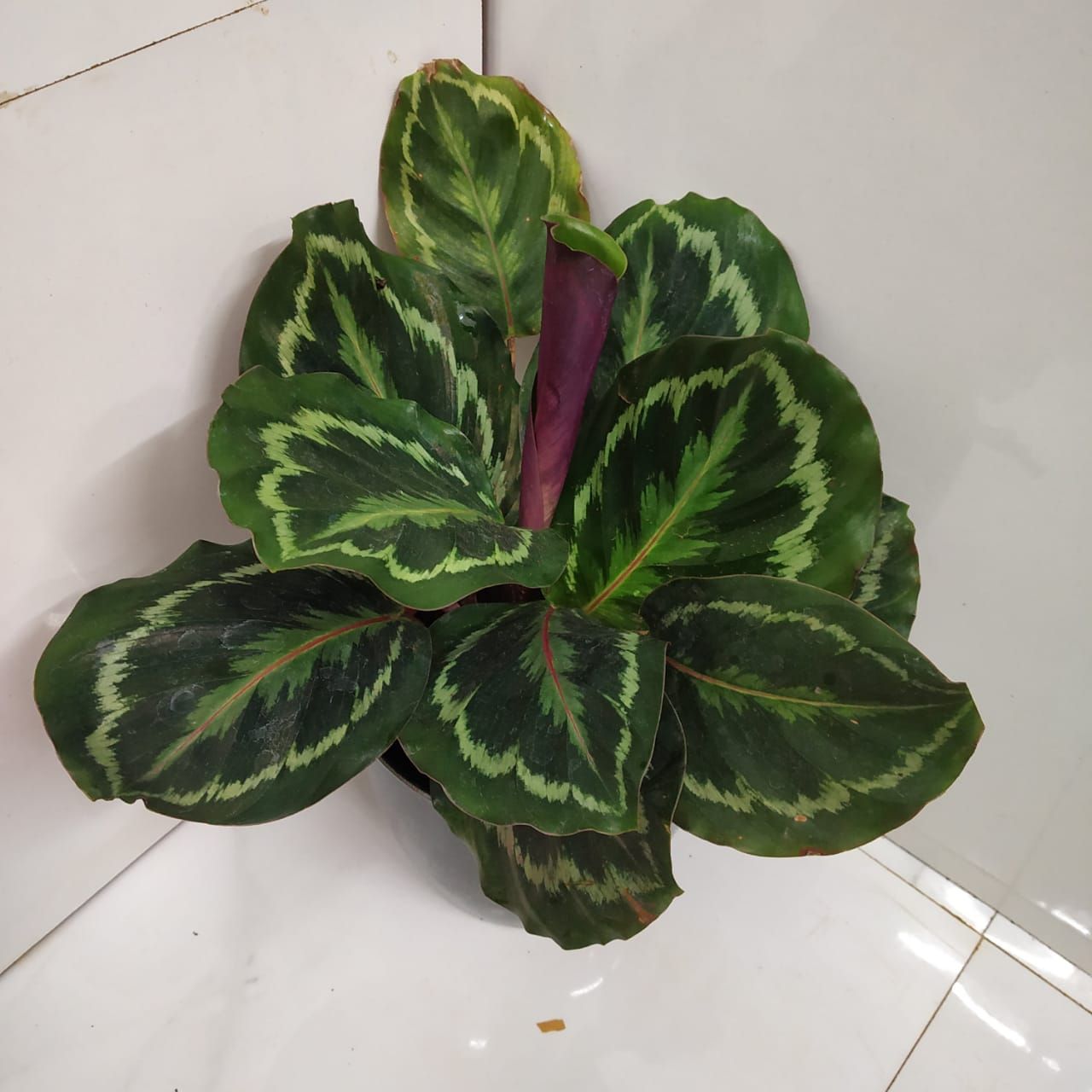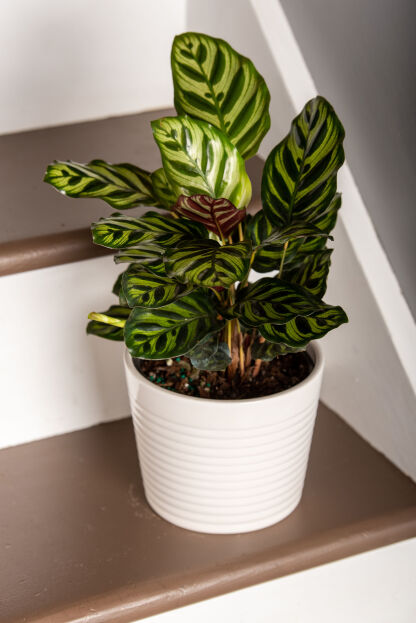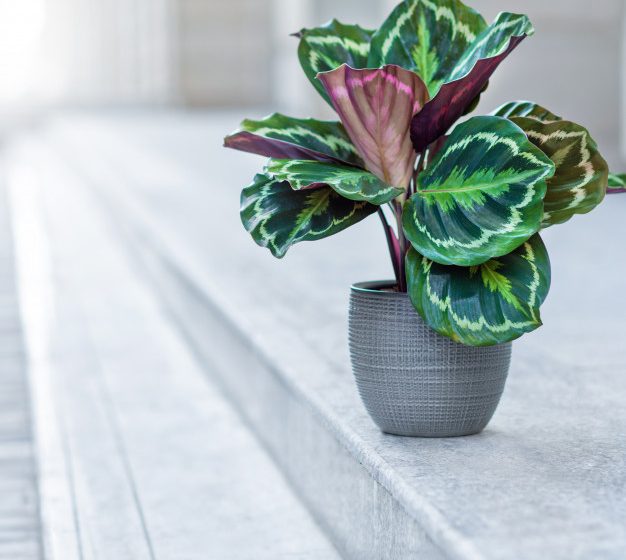Understanding the Unique Needs of Your Calathea Plant
Calathea plants are known for their stunning foliage and vibrant colors, but they can be finicky when it comes to their care. To provide optimal care for your Calathea plant, it’s essential to understand its unique needs. One of the most critical factors to consider is light. Calathea plants prefer bright, indirect light but can tolerate low light conditions. However, direct sunlight can cause the leaves to become scorched and discolored. When it comes to temperature, Calathea plants prefer temperatures between 65-75°F (18-24°C), making them an ideal choice for indoor spaces. Humidity is also crucial, as Calathea plants thrive in environments with a relative humidity of 50-60%. By understanding these specific needs, you can create an environment that allows your Calathea plant to flourish.
Another critical aspect of Calathea care is watering. Overwatering is a common mistake that can lead to root rot and other problems. To avoid this, it’s essential to check the soil moisture regularly and adjust your watering schedule accordingly. A well-draining potting mix can also help prevent waterlogged soil. By providing the right environment and watering conditions, you can help your Calathea plant thrive and enjoy its beautiful foliage for years to come. When learning how to care for Calathea plant, it’s essential to remember that every plant is unique, and what works for one plant may not work for another. By observing your plant’s responses to different conditions and adjusting your care accordingly, you can develop a deeper understanding of its needs and provide the best possible care.
By understanding the unique needs of your Calathea plant, you can create a care routine that meets its specific requirements. This includes providing the right environment, watering conditions, and fertilization. By following these guidelines and observing your plant’s responses, you can help your Calathea plant thrive and enjoy its beautiful foliage for years to come. Whether you’re a seasoned plant enthusiast or just starting to learn how to care for Calathea plant, with the right care and attention, you can enjoy the beauty and benefits of these stunning plants.
How to Provide the Perfect Environment for Your Calathea
Creating an ideal environment for your Calathea plant is crucial for its growth and well-being. When it comes to lighting, Calathea plants prefer bright, indirect light. Placing your plant near an east- or west-facing window is ideal, as it will receive gentle, indirect light. Avoid placing your Calathea in direct sunlight, as it can cause the leaves to become scorched and discolored. If you don’t have a window with indirect light, you can also use grow lights to provide the necessary light for your plant.
Temperature is also an essential factor to consider when creating an environment for your Calathea plant. These plants prefer temperatures between 65-75°F (18-24°C), making them an ideal choice for indoor spaces. Avoid placing your Calathea near heating or cooling vents, fireplaces, or drafty windows, as this can cause the temperature to fluctuate. By maintaining a consistent temperature, you can help your Calathea plant thrive.
Humidity is another critical factor to consider when creating an environment for your Calathea plant. These plants prefer a humid environment, typically between 50-60% relative humidity. To maintain the right humidity level, you can place the pot on a tray filled with water and pebbles or use a humidifier. By maintaining the right humidity level, you can help prevent pest problems and ensure your Calathea plant stays healthy.
By providing the right environment, including lighting, temperature, and humidity, you can help your Calathea plant thrive. Remember, every plant is unique, and what works for one plant may not work for another. By observing your plant’s responses to different conditions and adjusting your care accordingly, you can develop a deeper understanding of its needs and provide the best possible care. When learning how to care for Calathea plant, it’s essential to remember that creating an ideal environment is just the first step in providing optimal care.
The Art of Watering Your Calathea: A Delicate Balance
Watering is one of the most critical aspects of Calathea care, and it requires a delicate balance. Overwatering is a common mistake that can lead to root rot and other problems, while underwatering can cause the leaves to become dry and brittle. To avoid these issues, it’s essential to understand the watering needs of your Calathea plant.
The key to proper watering is to check the soil moisture regularly. Stick your finger into the soil up to the first knuckle, and if the soil feels dry, it’s time to water. If the soil feels damp or wet, wait another day or two before watering again. This simple technique will help you avoid overwatering and ensure your Calathea plant receives the right amount of moisture.
Another important factor to consider is the watering schedule. Calathea plants prefer to be watered in the morning, so the pot has a chance to dry out slightly before nightfall. Avoid getting water on the leaves or crown of the plant, as this can cause rot and other problems. Instead, water at the soil level, and make sure the pot has good drainage holes to prevent waterlogged soil.
When learning how to care for Calathea plant, it’s essential to remember that watering needs may vary depending on the time of year and the environment. During the spring and summer months, Calathea plants require more frequent watering, while during the fall and winter months, they require less. By adjusting your watering schedule accordingly, you can ensure your Calathea plant receives the right amount of moisture and thrives.
By mastering the art of watering your Calathea plant, you can help prevent common problems and ensure your plant stays healthy and thriving. Remember to check the soil moisture regularly, avoid overwatering, and adjust your watering schedule according to the time of year and environment. With these simple tips, you can provide your Calathea plant with the right amount of moisture and enjoy its beautiful foliage for years to come.
Fertilizing Your Calathea: A Guide to Promoting Healthy Growth
Fertilizing is an essential part of Calathea care, as it provides the necessary nutrients for healthy growth and development. When learning how to care for Calathea plant, it’s essential to understand the importance of fertilization and how to do it correctly. Calathea plants require a balanced fertilizer that is high in nitrogen, phosphorus, and potassium. A fertilizer with a ratio of 20-20-20 (nitrogen-phosphorus-potassium) is ideal for Calathea plants.
When it comes to fertilizing your Calathea plant, it’s essential to follow a few guidelines. First, fertilize your plant during the growing season (spring and summer), as this is when the plant is actively producing new growth. Avoid fertilizing during the dormant season (fall and winter), as this can cause the plant to produce weak and leggy growth. Second, use a water-soluble fertilizer, as this is easier to absorb and less likely to cause burning. Finally, dilute the fertilizer to half the recommended strength, as Calathea plants are sensitive to overfertilization.
Overfertilization is a common mistake that can cause more harm than good. When a Calathea plant is overfertilized, it can cause the leaves to become scorched and discolored, and the roots to become burned. This can lead to a range of problems, including root rot and pest infestations. By fertilizing your Calathea plant correctly, you can promote healthy growth and development, and avoid the risks associated with overfertilization.
In addition to using a balanced fertilizer, you can also use other types of fertilizers to promote healthy growth. For example, you can use a fertilizer that is high in phosphorus to promote root growth and development. You can also use a fertilizer that is high in potassium to promote healthy leaf growth and development. By using a combination of fertilizers, you can provide your Calathea plant with the necessary nutrients for optimal growth and development.
By following these guidelines and using the right type of fertilizer, you can promote healthy growth and development in your Calathea plant. Remember to fertilize your plant during the growing season, use a water-soluble fertilizer, and dilute the fertilizer to half the recommended strength. With these simple tips, you can provide your Calathea plant with the necessary nutrients for optimal growth and development.
Pruning and Grooming: Maintaining Your Calathea’s Natural Beauty
Pruning and grooming are essential parts of Calathea care, as they help maintain the plant’s natural beauty and promote healthy growth. When learning how to care for Calathea plant, it’s essential to understand the importance of pruning and grooming. Pruning involves removing dead or dying leaves and stems, while grooming involves maintaining good air circulation and preventing pests.
To prune your Calathea plant, start by removing any dead or dying leaves or stems. Use a pair of clean scissors or pruning shears to cut off the affected areas, making sure to disinfect the tools between cuts. This will help prevent the spread of disease and encourage healthy growth. Next, inspect the plant for any signs of pests, such as spider mites, mealybugs, or scale. If you find any pests, treat the plant with insecticidal soap or neem oil according to the product’s instructions.
In addition to pruning, it’s also essential to maintain good air circulation around your Calathea plant. This can be achieved by placing the plant at least 6-8 inches away from any walls or other plants. Good air circulation helps prevent fungal diseases and promotes healthy growth. You can also use a fan to circulate the air around the plant, especially in humid environments.
Another important aspect of grooming is dusting the leaves. Calathea plants have beautiful, delicate leaves that can become dusty over time. To dust the leaves, use a soft-bristled brush or a damp cloth to gently remove any dust or debris. This will help maintain the plant’s natural beauty and promote healthy growth.
By pruning and grooming your Calathea plant regularly, you can maintain its natural beauty and promote healthy growth. Remember to remove any dead or dying leaves or stems, maintain good air circulation, and dust the leaves regularly. With these simple tips, you can keep your Calathea plant looking its best and enjoy its beautiful foliage for years to come.
Pest Control and Common Problems: Identifying and Solving Issues
Calathea plants are generally hardy and resistant to pests, but they can still be affected by common problems. When learning how to care for Calathea plant, it’s essential to be aware of these potential issues and know how to address them. One of the most common pests that can affect Calathea plants is spider mites. These tiny, spider-like insects can cause yellowing or bronzing of the leaves and can be difficult to spot.
To identify spider mites, look for fine webbing on the leaves or stems of the plant. If you suspect that your Calathea plant has spider mites, treat it with insecticidal soap or neem oil according to the product’s instructions. Another common pest that can affect Calathea plants is mealybugs. These small, white insects can cause stunted growth and yellowing of the leaves.
To identify mealybugs, look for small, white, cottony patches on the leaves or stems of the plant. If you suspect that your Calathea plant has mealybugs, treat it with insecticidal soap or neem oil according to the product’s instructions. Root rot is another common problem that can affect Calathea plants. This can be caused by overwatering or poor drainage and can lead to the death of the plant.
To prevent root rot, make sure to water your Calathea plant carefully and avoid getting water on the leaves or crown of the plant. Also, ensure that the pot has good drainage holes to prevent waterlogged soil. If you suspect that your Calathea plant has root rot, repot it in fresh soil and a well-draining pot, and reduce watering.
By being aware of these common problems and knowing how to address them, you can keep your Calathea plant healthy and thriving. Remember to inspect your plant regularly for signs of pests or disease, and take action promptly if you notice any issues. With proper care and attention, your Calathea plant can provide you with beautiful foliage and a touch of tropical elegance for years to come.
Repotting Your Calathea: A Step-by-Step Guide
Repotting is an essential part of Calathea care, as it provides the plant with fresh soil and a larger pot to accommodate its growing roots. When learning how to care for Calathea plant, it’s essential to understand the importance of repotting and how to do it correctly. Here’s a step-by-step guide on how to repot your Calathea plant:
Step 1: Choose the right pot. Select a pot that is only one to two sizes larger than the current pot. This will prevent the soil from becoming too wet and reduce the risk of root rot.
Step 2: Prepare the soil. Use a well-draining potting mix specifically designed for tropical plants like Calathea. Avoid using regular potting soil, as it can retain too much water and cause root rot.
Step 3: Remove the plant from the pot. Gently remove the plant from the pot, taking care not to damage the roots. If the plant is stuck, run a knife or spatula around the inside of the pot to loosen it.
Step 4: Inspect the roots. Inspect the roots for any signs of damage or rot. If you find any damaged or rotting roots, trim them off with a pair of clean scissors or pruning shears.
Step 5: Plant the Calathea. Place the Calathea plant in the new pot, making sure the soil level is the same as it was in the original pot. Add fresh potting mix around the roots, gently firming it in place.
Step 6: Water the plant. Water the plant thoroughly after repotting, making sure the soil is moist but not waterlogged.
By following these steps, you can successfully repot your Calathea plant and provide it with the fresh soil and larger pot it needs to thrive. Remember to repot your Calathea plant every one to two years, or when the plant becomes pot-bound.
Propagation and Division: Sharing Your Calathea with Others
Propagation and division are great ways to share your Calathea plant with friends and family, and to create new plants for your own collection. When learning how to care for Calathea plant, it’s essential to understand the process of propagation and division, and how to do it correctly.
One way to propagate Calathea plants is through leaf cuttings. This involves cutting off a healthy leaf from the mother plant, and planting it in a pot filled with a well-draining mix. Keep the soil moist and warm, and roots should develop within a few weeks. Once the new plant has developed a robust root system, it can be transplanted into a larger pot.
Another way to propagate Calathea plants is through division. This involves dividing the roots of the mother plant, and replanting the separated sections in new pots. This method is best done in the spring, when the plant is actively growing. Make sure to handle the roots carefully, and to provide the new plants with plenty of water and nutrients.
Propagation and division are not only great ways to share your Calathea plant with others, but they are also a great way to create new plants for your own collection. By following these simple steps, you can create new Calathea plants that will thrive and bring joy to your home or office.
When propagating or dividing Calathea plants, it’s essential to remember to provide the new plants with the right conditions. This includes plenty of light, water, and nutrients. Make sure to keep the soil moist, but not waterlogged, and to provide the plants with a well-draining mix.
By following these simple steps, you can successfully propagate and divide your Calathea plant, and share it with others. Remember to handle the roots carefully, and to provide the new plants with plenty of water and nutrients. With a little practice and patience, you can create new Calathea plants that will thrive and bring joy to your home or office.





:max_bytes(150000):strip_icc()/kararileycalathea-19-e1799da10719478295ef034a08d76fe9.jpg)

:max_bytes(150000):strip_icc()/kararileycalathea-19-e1799da10719478295ef034a08d76fe9.jpg)

